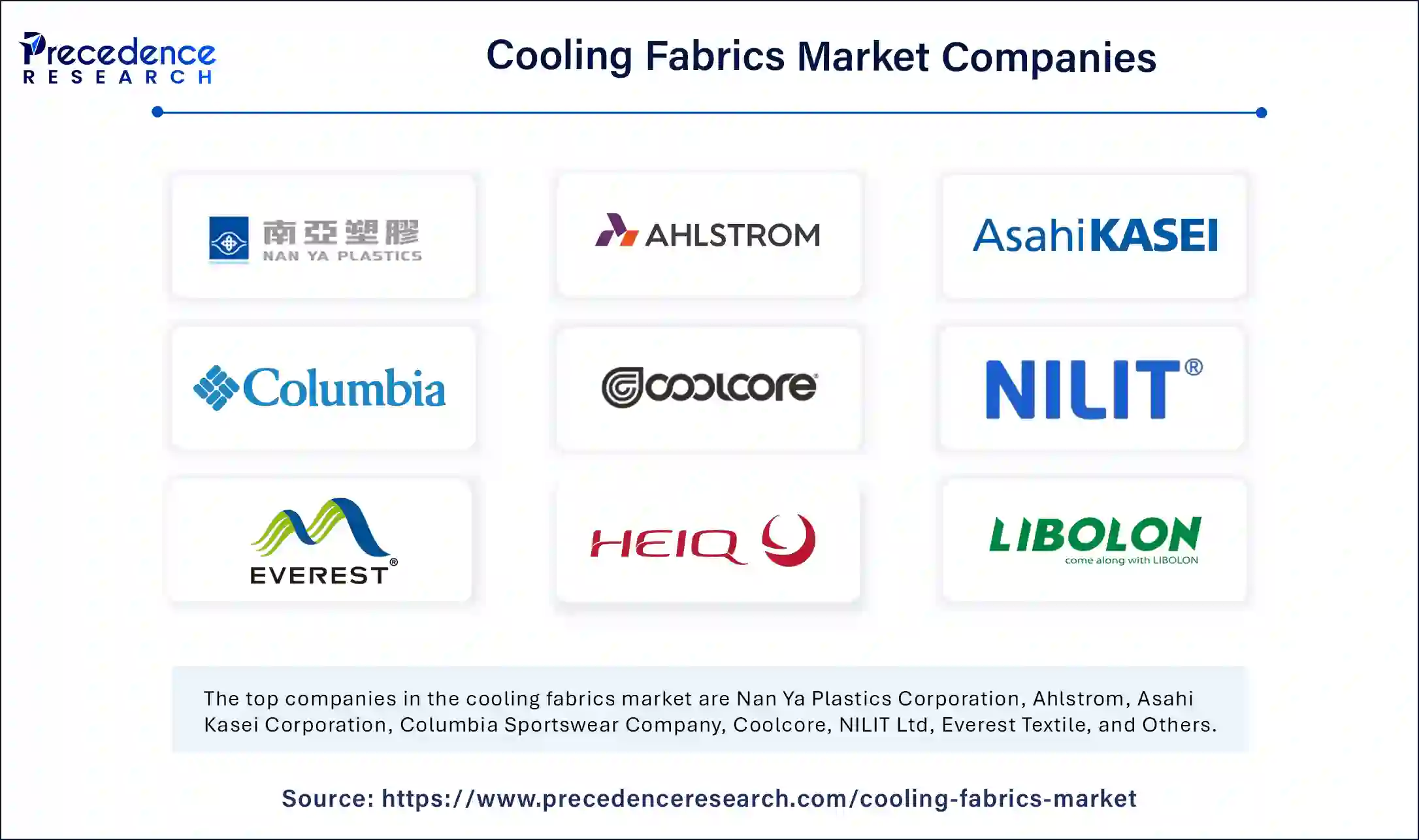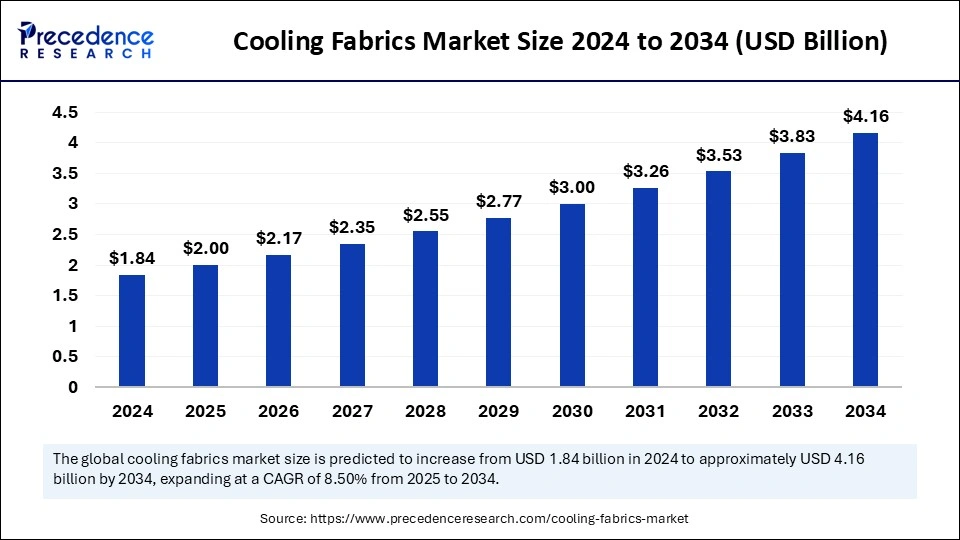Table of Contents
The global cooling fabrics market size was valued at USD 1.84 billion in 2024 and is expected to cross around USD 4.16 billion by 2034, growing at a CAGR 8.50% from 2025 to 2034.
Get a Free Sample Copy of the Report@ https://www.precedenceresearch.com/sample/5742
Cooling Fabrics Market Key Highlights
-
North America led the cooling fabrics market with a dominant 35% market share in 2024.
-
The Asia Pacific region is set to witness robust growth with a CAGR of 9.1% during the forecast period.
-
The synthetic segment emerged as the leading product category, capturing 72% of the market share in 2024.
-
The natural segment is expected to experience a steady CAGR of 8.05% throughout the forecast period.
-
The sports apparel segment accounted for the largest share, contributing 47% to the market in 2024.
-
The protective wear segment is anticipated to expand significantly during the forecast period.
AI Impact on the Cooling Fabrics Market
Artificial Intelligence (AI) is playing a transformative role in the cooling fabrics market by enhancing material innovation, optimizing production processes, and improving product performance. AI-powered data analytics and machine learning models are helping manufacturers develop advanced cooling textiles with superior moisture-wicking, breathability, and thermal regulation capabilities. By analyzing large datasets related to fabric performance, AI enables the creation of smart textiles that can adapt to different environmental conditions, offering users enhanced comfort and efficiency.
AI-driven automation is also streamlining manufacturing processes by improving quality control, reducing material waste, and optimizing resource allocation. Predictive analytics allows companies to anticipate market trends and consumer preferences, ensuring that new cooling fabrics meet evolving demands in sports apparel, medical textiles, and protective clothing. Additionally, AI-integrated smart fabrics with embedded sensors are emerging, enabling real-time temperature regulation and personalized cooling effects. As AI continues to evolve, its integration into cooling fabrics will drive sustainability, innovation, and market expansion.
Market Overview
The cooling fabrics market is experiencing significant growth due to rising consumer demand for high-performance textiles that offer comfort, breathability, and temperature regulation. These fabrics are widely used in sports apparel, protective clothing, and medical textiles, driven by advancements in material science and technology. Innovations in synthetic and natural cooling fabrics have enhanced their moisture-wicking and heat dissipation properties, making them highly desirable across multiple industries.
Market Scope
| Report Coverage | Details |
| Market Size by 2034 | USD 4.16 Billion |
| Market Size in 2025 | USD 2.00 Billion |
| Market Size in 2024 | USD 1.84 Billion |
| Market Growth Rate from 2025 to 2034 | CAGR of 8.50% |
| Dominated Region | North America |
| Fastest Growing Market | Asia Pacific |
| Base Year | 2024 |
| Forecast Period | 2025 to 2034 |
| Segments Covered | Product, Application, and Regions |
| Regions Covered | North America, Europe, Asia-Pacific, Latin America and Middle East & Africa |
Market Dynamics
Market Drivers
Key factors driving the cooling fabrics market include the increasing adoption of activewear and sports apparel, growing awareness of heat-related health risks, and technological advancements in textile manufacturing. The demand for lightweight, sweat-resistant fabrics has surged, especially among athletes and outdoor workers. Additionally, sustainability initiatives are encouraging the development of eco-friendly cooling fabrics, further propelling market growth.
Market Opportunities
Significant opportunities lie in the integration of smart textiles with AI-driven temperature control systems, enabling adaptive cooling properties. The expansion of cooling fabric applications in medical and military fields also presents growth potential. With rising concerns over climate change and global warming, consumers and industries are increasingly seeking innovative cooling solutions, opening new doors for product diversification and market expansion.
Market Challenges
Despite strong growth, the market faces challenges such as high production costs, limited consumer awareness in developing regions, and the complexity of developing multi-functional cooling fabrics. Maintaining the durability and efficiency of cooling properties over time remains a concern for manufacturers. Additionally, balancing performance with sustainability efforts requires ongoing research and investment.
Regional Insights
North America dominates the cooling fabrics market, largely due to a high demand for performance wear and the presence of leading textile manufacturers. The Asia Pacific region is expected to experience rapid growth, driven by increasing sports and fitness trends, rising disposable income, and the expansion of the textile industry. Europe is also witnessing steady demand, particularly in protective wear and medical applications, contributing to the overall market growth.
Cooling Fabrics: An Overview
Cooling fabrics are advanced textiles designed to regulate body temperature by enhancing airflow, moisture absorption, and heat dissipation. These fabrics help in keeping the wearer cool and comfortable, making them ideal for applications in sportswear, protective clothing, medical textiles, and everyday apparel. Cooling fabrics work through various mechanisms, including evaporative cooling, phase-change materials (PCMs), and moisture-wicking technology.
Types of Cooling Fabrics
Cooling fabrics are primarily categorized into synthetic and natural fabrics. Synthetic cooling fabrics, such as polyester and nylon blends, dominate the market due to their durability, lightweight nature, and enhanced moisture-wicking properties. Natural cooling fabrics, including cotton, linen, and bamboo-based textiles, offer eco-friendly alternatives with breathability and softness. Many manufacturers are now integrating advanced technologies like microencapsulation and nanotechnology to improve cooling efficiency.
Key Applications of Cooling Fabrics
The demand for cooling fabrics is rapidly growing across various sectors. Sports and fitness apparel is one of the leading applications, as athletes require breathable and sweat-resistant fabrics to enhance performance. Protective clothing, including military and industrial workwear, incorporates cooling fabrics to ensure comfort in extreme environments. Medical textiles use these fabrics for temperature regulation in patients, while casual and fashion wear is increasingly adopting cooling textiles to provide comfort in warm climates.
Market Growth and Trends
The cooling fabrics market is witnessing significant expansion due to increasing consumer awareness of heat management and the growing popularity of high-performance clothing. Climate change and rising global temperatures are further driving the demand for cooling textiles. Technological advancements, such as smart textiles embedded with temperature-regulating sensors, are revolutionizing the market. Additionally, sustainability trends are encouraging the development of biodegradable and recycled cooling fabrics.
Cooling Fabrics Market Companies

- Nan Ya Plastics Corporation
- Ahlstrom
- Asahi Kasei Corporation
- Columbia Sportswear Company
- Coolcore
- NILIT Ltd
- Everest Textile
- FORMOSA TAFFETA CO., LTD.
- HeiQ Materials AG
- Libolon
- Liebaert
Latest Announcement by Industry Leaders
- In February 2024, Nan Ya Plastics Corp. and Taiwan Mitsui Chemicals, Inc., the subsidiary of Mitsui Chemicals, Inc., announced their efforts in the market development for biomass-based plastic products. In the program, the NPC obtained the biomass-based acetone from Mitsui Chemicals, which will be used in the biomass-derived bisphenol A (BPA) manufacturing in Taiwan.
Recent Developments
- In March 2025, BEDGEAR® launched BEDGEAR Home, a new brand that is working on extending the brand’s moisture-wicking and cooling fabric technologies over the mattress to the home textiles.
- In February 2025, Noble Biomaterials, a leading player in antimicrobial and conductive solutions designed for soft surface applications, collaborated with Coolcore, a leading producer in chemical-free thermoregulation fabrics, to launch COOLPRO fabric, the transformative fabric technology that enhances the advanced cooling performance with antimicrobial protection.
Segments Covered in the Report
By Product
- Synthetic
- Natural
By Application
- Sports Apparel
- Protective Wear
- Lifestyle
- Others
By Geography
- North America
- Europe
- Asia-Pacific
- Latin America
- Middle East & Africa
Also Read: Security Inks Market
Ready for more? Dive into the full experience on our website@ https://www.precedenceresearch.com/

